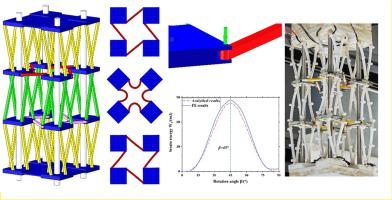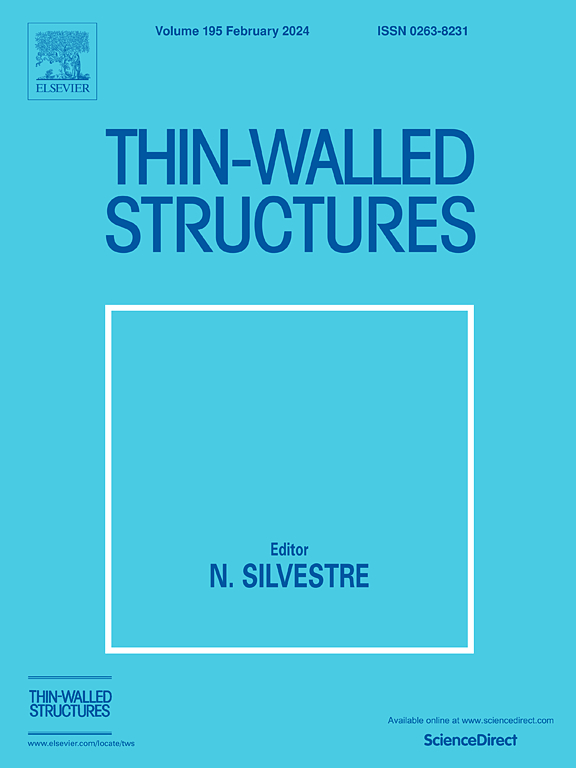A temperature-regulated multi-material compression-torsion metamaterial with local bistability
IF 5.7
1区 工程技术
Q1 ENGINEERING, CIVIL
引用次数: 0
Abstract
In this paper, based on the compression-torsion coupling structure, we designed and fabricated a structure that exhibits a temperature-controlled local bistability phenomenon during uniaxial compression at different temperatures. In the structure, based on the quadrilateral rigid frames, the flexible connecting bands are hinged to the frames by pins, and the shape memory polymer inclined struts are bonded to the frames. The compression-torsion coupling causes the bend of the inclined struts and the rotation of the rigid frames, then causing the connecting bands to post-buckling. The inclined struts can adjust and control the deformation process under thermal loads, because the modulus of the shape memory polymer is controlled by temperature, so that the deformation of the structure is reversible/irreversible under programmable temperature/displacement loads. The analytical model and numerical simulation show that the local bistability can be achieved under temperature control and different boundary conditions. An assembled metamaterial structure is fabricated by combining 3D printed parts. The relationships between the reversibility/irreversibility of the structural deformation and temperature/displacement loads are verified by experiments. The local bistable phenomenon enables the structure to remember the history of the load, providing inspiration for new functional designs in the fields of intelligent memory, encoding display, and vibration energy absorption.

具有局部双稳态性的温度可调多材料压缩扭转超材料
本文以压缩-扭转耦合结构为基础,设计并制造了一种在不同温度下进行单轴压缩时表现出温控局部双稳态现象的结构。在该结构中,以四边形刚性框架为基础,柔性连接带通过销钉与框架铰接,形状记忆聚合物斜支撑与框架粘合。压缩-扭转耦合使斜杆弯曲,刚性框架旋转,然后使连接带发生后屈曲。由于形状记忆聚合物的模量受温度控制,因此在可编程的温度/位移载荷作用下,结构的变形是可逆/不可逆的。分析模型和数值模拟表明,在温度控制和不同的边界条件下,可以实现局部双稳态。通过结合三维打印部件,制造出了装配式超材料结构。实验验证了结构变形的可逆性/不可逆性与温度/位移载荷之间的关系。局部双稳态现象使结构能够记住负载的历史,为智能记忆、编码显示和振动能量吸收等领域的新型功能设计提供了灵感。
本文章由计算机程序翻译,如有差异,请以英文原文为准。
求助全文
约1分钟内获得全文
求助全文
来源期刊

Thin-Walled Structures
工程技术-工程:土木
CiteScore
9.60
自引率
20.30%
发文量
801
审稿时长
66 days
期刊介绍:
Thin-walled structures comprises an important and growing proportion of engineering construction with areas of application becoming increasingly diverse, ranging from aircraft, bridges, ships and oil rigs to storage vessels, industrial buildings and warehouses.
Many factors, including cost and weight economy, new materials and processes and the growth of powerful methods of analysis have contributed to this growth, and led to the need for a journal which concentrates specifically on structures in which problems arise due to the thinness of the walls. This field includes cold– formed sections, plate and shell structures, reinforced plastics structures and aluminium structures, and is of importance in many branches of engineering.
The primary criterion for consideration of papers in Thin–Walled Structures is that they must be concerned with thin–walled structures or the basic problems inherent in thin–walled structures. Provided this criterion is satisfied no restriction is placed on the type of construction, material or field of application. Papers on theory, experiment, design, etc., are published and it is expected that many papers will contain aspects of all three.
 求助内容:
求助内容: 应助结果提醒方式:
应助结果提醒方式:


